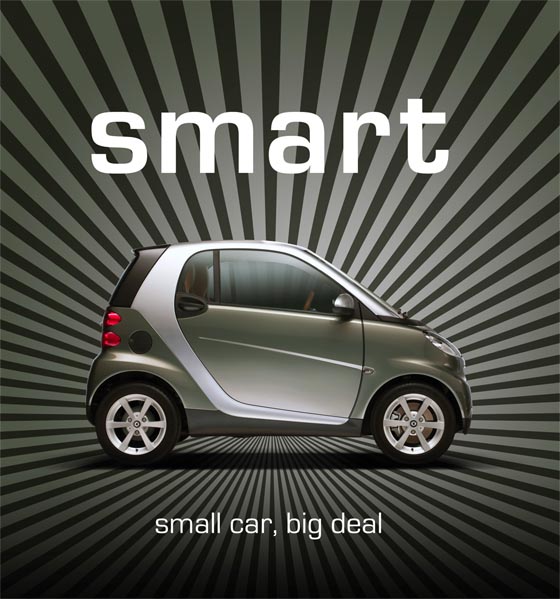Calgary Herald, Smart: Small Car, Big Deal book review, by Greg Williams
Smart: Small Car, Big Deal makes for smart reading.
Whether you have an interest in the Smart car or not this book proves fascinating as it details the many different facets of how a new automobile –especially in this day and age – enters into production.
Smart retells the history of the little car, from conception through design to final product. It also highlights the company’s environmental responsibility as the cars are produced at the green ‘Smartville’ factory in Hambach, France.
The book was originally published in Germany in 2007 as Smartism. With the arrival of the Smart car in the U.S., publisher Motorbooks renamed and printed the work (ISBN-13: 978-0-7603-3521-5, softcover, 180 pages, 300 colour photos, $32.95, www.motorbooks.com).
Smart is part art book with its many colour photos of the cars, the people who drive them, and images of the Smartville factory. Also included are several colourful examples of Smart’s advertising and design sketches.
However, the words written by authors Willi Diez and Jurgen Zollter are as illustrative as the photographs. The stories these two writers tell help peel away the many layers of the Smart story.
Divided into three sections – History & Technology, Analysis & Prognosis and The New One: 451 – Smart takes readers back to 1972. We’re told how Mercedes-Benz created a concept for a small car that the company thought would meet driver demands in the year 2000. While the designs might now look a little naïve, as originally sketched the concept car had dimensions similar to today’s Smart car. To prove the mini-car’s viability test mules of the 2.5-metre long two-seater were constructed.
The project was held back due to safety concerns. It wasn’t clear how such a small car could be constructed and live up to the safety requirements for which Mercedes-Benz as a brand was famous. But the company didn’t give up. In 1981, Mercedes-Benz developed a concept vehicle dubbed NAFA, the “Nahverkehrsfahrzeug”, or Local Traffic Vehicle. A prototype was made, but again, the project was put on the back burner. While the NAFA took into consideration safety with rigid side impact protection and ‘controlled deformation body components’ there just wasn’t a ready and willing market for a micro car.
Then in the late 1980s the California Clean Air Act was announced. The act stipulated that by 2002 at least 10 per cent of every major automaker’s cars sold in the state would have to be Zero Emissions Vehicles.
This spurred Mercedes-Benz to work on the MCC, or Micro Compact Car, and the company set up a design studio in Irvine, Calif. The design team worked in the community as well as in the studio, studying urban mobility issues as they attempted to sketch a pleasing design for the two-seater. Prototypes – the Eco Sprinter and Eco Speedster — were built in 1993.
Enter Nicolas G. Hayek, the man responsible for the Swatch watch. He wanted to revolutionize the auto industry with a car fit for an urban market, and Hayek figured he could apply his Swatch watch making concepts to car manufacturing.
In 1994 Micro Compact Car AG was established as a joint venture between Daimler-Benz AG (51 per cent share) and the Swiss Corporation for Microelectronics and Watch Making Industries Ltd. (49 per cent share). The car needed a name, and it was derived from Swatch Mercedes Art – or Smart.
Propulsion was an issue, and electric, hybrid, gas and diesel power were all considered. In the end, gas/diesel variants won out, and the Smart car was shown at numerous venues in 1995 and 1996. In 1997, Daimler-Benz bought out Hayek’s shares of MCC, and the Smart car was shown at the Frankfurt International Automobile Show.
The Smart measured in at 2.5 m long, 1.51 m wide and 1.52 m tall. A three-cylinder gas engine sat in the back of the car, and safety was assured through the Tridion safety cell together with front and rear crush zones and modern restraint systems. The body consisted, and still consists, of dyed thermoplastic panels, including a front and rear clip and doors.
The first Smart cars were sold in Europe in October 1998. In 1999 a direct-injection diesel engine found its way into the vehicle – and this was the engine powering the Smart when it debuted in Canada in 2004.
Smart – the book – takes a look at the turbulent times felt by parent company DaimlerChrysler in the mid-2000s, and how Smart the brand almost became a footnote in automotive history. With some restructuring and paring of jobs Smart weathered the storm, and the cars – now in their second generation with the new model 451 coupes and cabriolets — continue to be some of the most economic and climate-friendly vehicles in mass production.
Check Amazon.ca – at the time of this writing Smart: Small Car, Big Deal was listed as available and priced at $20.78.

